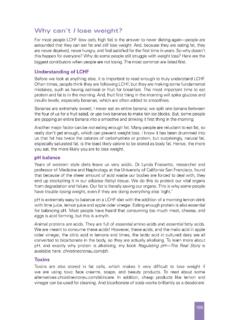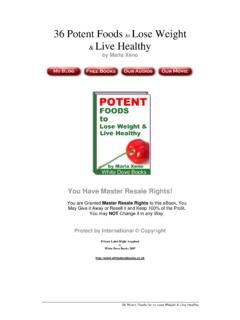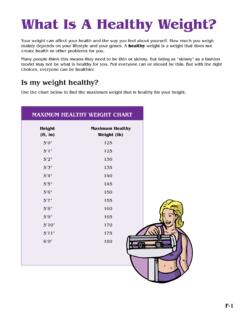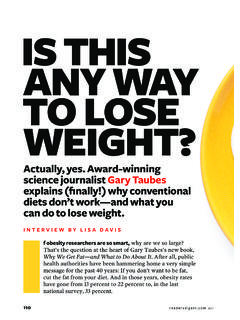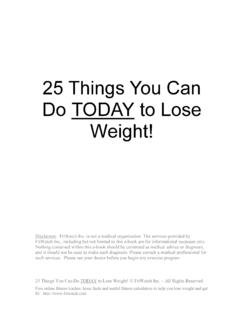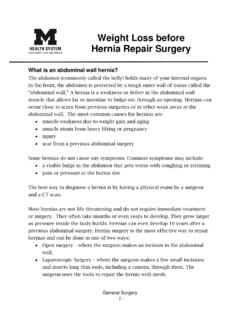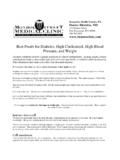Transcription of Can eating fruits and vegetables help people to manage ...
1 vegetables help people to manage their weight ? Can eating fruits and Summary Consuming a diet high in fruits and vegetables is associated with lower risks for numerous chronic diseases, including cancer and cardiovascular ,2 Even so, the impact of eating fruits and vegetables on weight management has not been widely researched. This brief will examine the evidence from available studies to determine whether eating fruits and vegetables can help with weight management. We are providing only the outcomes of these studies, but we encourage you to read the articles themselves to gain many more insights into the health aspects of eating fruits and vegetables . The research that we cover in this brief will support the conclusion that replacing foods of high energy density (high calories per weight of food) with foods of lower energy density, such as fruits and vegetables , can be an important part of a weight management strategy.
2 Extensive research has been conducted on the relationships between calories, amount of food eaten and body weight . The association of this information with the role of fruits and vegetables in weight management can be summarized as follows: To lose weight a person must eat fewer calories than what he or she expends. people may not limit what they consume based on calories alone. Feeling full is one reason that people stop eating . Short-term studies indicate that the volume of food people eat at a meal is what makes them feel full and stop eating , rather than the calorie content of the food. At the same calorie level, foods with low energy density provide a greater volume of food, which may help people feel full at a meal while consuming fewer calories.
3 Water and fiber increase the volume of foods and reduce energy density. In their natural state, fruits and vegetables have high water and fiber content and thus are low in calories and energy density. fruits and vegetables are good substitutes for foods of high energy density. Research Review: eating fruits and vegetables may help manage weight . Losing weight can be very difficult, even for the highly motivated. In addition, maintaining an appropriate weight is difficult, particularly as a person ages. Health care professionals need to provide sound, scientific information when they advise people to eat foods that help them stay healthy, which includes maintaining a suitable weight .
4 The research community is evaluating the effectiveness of a number of weight loss strategies; however, this brief examines only one strategy: the role that fruit and vegetable consumption may play in weight management. Very few studies in the literature have investigated whether there is a direct relationship between eating fruits and vegetables and losing weight . The studies in this brief examined many issues such as the relationships of calories, volume of food eaten, types of food eaten (including fruits and vegetables ), satiety, and weight reduction. Many of the studies reported on consumption of fruits and vegetables but did so in the context of a larger framework, such as preventing or treating high blood pressure or cardiac disease, but reported on weight loss also.
5 Research to Practice Series, No. 1 National Center for Chronic Disease Prevention and Health Promotion Division of Nutrition and Physical Activity Regardless of what types of food a person eats, the basic rule concerning weight loss is that to lose weight people must consume fewer calories than they expend. However, limitation of intake need not be based on calories. A feeling of being full is another reason that people stop eating . people eat more food than they need for many reasons. The popular term "comfort food" succinctly provides one reason: people eat foods that make them feel good, that give them comfort. Some may eat to overcome fatigue; others may mistake thirst for hunger.
6 This brief does not explore these issues, but instead looks at eating to the point of feeling full. Energy Density Energy density is the relationship of calories to the weight of food (calories per gram). Foods high in energy density have a large number of calories relative to their weight or volume (4 to 9 calories per gram of weight ). Foods high in energy density include low-moisture foods like crackers and cookies or high-fat foods like butter and bacon. Foods with medium energy density range from to 4 calories per gram of weight . Examples include hard-boiled eggs, dried fruits , bagels, broiled lean sirloin steak, hummus, grape jelly, whole wheat bread, and part-skim mozzarella.
7 Foods low in energy density have to calories per gram; those very low in energy density range from 0 to calories per gram. Examples of foods in these two groups include tomatoes, cantaloupe, broth-based soups, fat free cottage cheese, fat free yogurt, strawberries, broccoli, and turkey breast roasted with no skin. Most fresh fruits and vegetables fall into one of these two categories. Energy Density and Volume Short-term studies (mostly conducted over several days with limited food options) described in the following section indicate that feeling full is more likely to make a person stop eating than is the total caloric content of the food consumed.
8 Many people believe that consuming high-calorie foods will make them feel full, but a study by Duncan and colleagues3 provided contrary evidence. In their study 20 obese and nonobese participants ate as much as they wanted over 5 days from a diet that alternated from low-energy-density to high-energy-density foods. On the low-energy-density diet, the participants felt full with just over half the calories (1570 kcal) they needed to feel full on the high-energy-density diet (3000 kcal). The positive effect of the volume of food eaten on the feeling of being full was demonstrated by researchers who created a greater volume of milkshakes simply by adding air. In a study published in 2000 by Rolls and colleagues,4 28 men ate 3 meals in the laboratory 1 day a week for 4 weeks.
9 On 3 of the 4 days the participants were given a yogurt-based milkshake 30 minutes before lunch. The milkshakes varied in volume (300 ml, 450 ml, and 600 ml) and were equal in caloric content because the higher volume was achieved by incorporating air. All three "sizes" had identical ingredients and weighed the same. Calories consumed were 12% lower following consumption of the 600 ml milkshake, and participants reported greater increases in feelings of fullness after drinking the 450 ml milkshake or the 600 ml milkshake than after the 300 ml drink. For the same number of calories, people can eat foods with low energy density in greater volume than foods with high energy density.
10 This helps people feel full and yet consume fewer calories. In a study by Bell et al. (1998),5 3 groups of women were provided meals and an evening snack for 2 days. One group followed a low-calorie menu; the second, a medium-calorie menu; and the third, high-calorie menu. The 3 menus were similar except that more vegetables were offered in the medium- and low-calorie menus to reduce their overall caloric content. The researchers found that women in each group ate a similar amount of food, which resulted in the medium-calorie group consuming more calories than the low-calorie group and the high-calorie group consuming more than either of the other 2 groups. 2 Another study6 shows how water added to food increases volume and thus its overall impact on feeling full.











